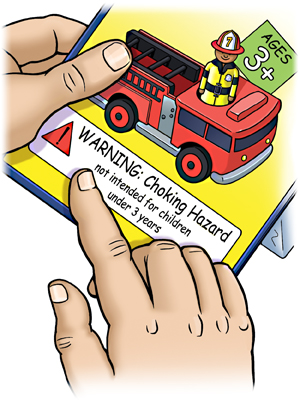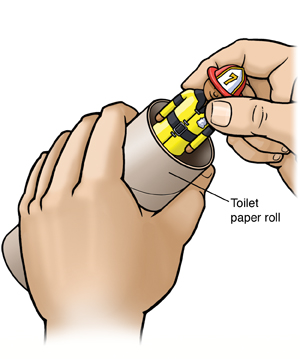From blocks and dolls to puzzles and games, toys can be fun and educational for children. But they can present safety hazards as well. As a parent, you need to be aware of toy safety issues for children of all ages. This sheet explains these issues and suggests ways to keep your children safe while playing with toys.
Toy tips
Follow these general tips to help keep your children safe:
-
Carefully follow manufacturer instructions on the assembly and use of toys.
-
Pay close attention to age recommendations. These tell you when a toy has small parts that are unsafe for young children to play with.
-
Check toys regularly for damages, such as sharp edges or loose small parts. Repair damaged toys right away or throw them away.
-
Make sure grandparents and other caregivers know about toy safety concerns.
-
When shopping for toys, do the following:
-
Think about the child’s age, interests, and skill level.
-
Read labels and follow age and safety information.
-
Look for well-made toys that can stand up to the wear-and-tear of children’s play. For instance, don't buy toys that look easy to break.
-
Choking: A major toy safety hazard
Little kids love to put things in their mouths. So, small toy parts present a big choking hazard. As a general rule, keep toys with small parts away from children under 3 years old. Also do the following:
-
Test small toys or parts for safety. Try this with a cardboard toilet paper roll. If items can fit into the roll, they're too small and should be kept away from young children. You can also buy a small-part toy tester at a toy store.
-
Keep small rounded and oval objects away from small children. These include balls and marbles. They also include small magnets used in some toys. Magnets aren't just a choking hazard. When swallowed, they can cause serious internal injuries.
-
Keep uninflated balloons and broken balloon pieces away from children. Latex balloons are the leading nonfood cause of choking deaths in children
-
Remove and discard all packaging from toys before giving them to small children.
-
Keep older kids’ toys stored away from young children’s toys.
-
Don’t let small children play with toys with strings, straps, or cords. A child can be strangled by these by accident.
Lead poisoning and toys
Lead poisoning from toys is less of a concern than choking on toys. But you should still be aware of the hazards. Lead is a poisonous metal. For years it was used in making paint, gasoline, plumbing, toys, toy jewelry, and furniture. Children can get lead poisoning by putting toys containing lead in their mouths. Lead poisoning can cause lifelong (permanent) problems with kids’ growth, behavior, and learning abilities. It can even cause death. Do the following to keep your child safe from lead:
-
Be alert to toy recalls (see box below).
-
If your child’s healthcare provider advises it, get your child a blood test. This can tell you if your child has lead in their system.
Teach your kids toy safety
With a little instruction, your children can help keep themselves safe when playing with toys. For instance, older kids can help watch younger kids playing with toys. Teach all children to:
-
Play safely with each toy.
-
Put toys away after using them. This helps prevent tripping hazards.
-
Stop playing with a toy if it's broken, and also tell an adult about it.
Safety recalls
If a toy is found to be a safety hazard, it may be recalled. This means it won't be sold anymore, and you may be able to get a refund of your purchase price. To learn about recalls, check with the U.S. Consumer Product Safety Commission at www.cpsc.gov . You can sign up to receive emails on product recalls. Also, if you find a problem with a toy, report it to the CPSC.
Featured in



